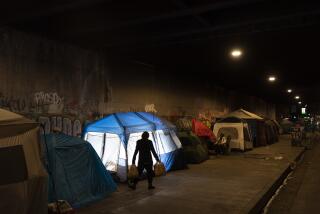Sign Language
- Share via
In my work as a photographer, my subjects are often artifacts and animals behind glass in museums. I view them through a glass lens. And I began to notice that the glass, in museums or a television screen or even the camera in front of me, was a barrier between me and reality.
I found that when I reached the end of a Southern California freeway off-ramp, I would sit and stare ahead as I waited for traffic or a light. Often, there were homeless people standing on the other side of the glass, the other side of reality. I would ignore them, stare ahead, deny any eye contact. But one day about a year ago, I lowered the window.
I began stopping, getting out of the car, taking part in the conversation that is offered on the signs people hold up on those off-ramps, asking for contact and cash. I explain that I want to buy the sign, and I offer new cardboard and a marker. I note the person’s name and location, ask how old they are, how long they’ve been on the street.
The signs follow few formal codes. Many say “homeless,” many say they are “Vets.” Occasionally there are misspellings, frequently the edges are dirty. The signs, highly personalized, are folded, put away for day after day of use.
As a matter of principle, I ask how much they would be willing to sell the sign for. If it’s a few dollars, I always give at least $5 or $10 so they can at least get a meal with the money. I’ve paid more--up to a few hundred dollars in one instance, when I became fascinated by a man from the former Soviet Union and kept returning to give him money.
I always try to communicate, talk a few minutes to socialize, shake a hand, say “good luck.” And each time I stop, I put down my camera. I do not photograph these people but make a specific attempt to be directly involved with them.
I’m frequently with my children. My 12-year-old son is usually embarrassed by any unusual behavior by his dad, but my 9-year-old feels pride in the kindness of the act and is surprisingly unashamed to accompany me.
I have several hundred signs now--more than I can ever imagine using, but I’m still collecting, and I come home at the end of a day reasonably broke. The piece you see here is a detail of a room in my house, and the area covered by the photograph is 12 feet by 12 feet.
Why am I collecting the signs? I like them because they represent a period of communication, when the glass is removed, when we’re no longer separated from reality, when people talk. I want this collection to represent a non-threatening chorus. It’s a space for the many voices that we’d all hear--and respond to--if we weren’t isolated, safe behind automotive glass.
More to Read
Sign up for Essential California
The most important California stories and recommendations in your inbox every morning.
You may occasionally receive promotional content from the Los Angeles Times.













